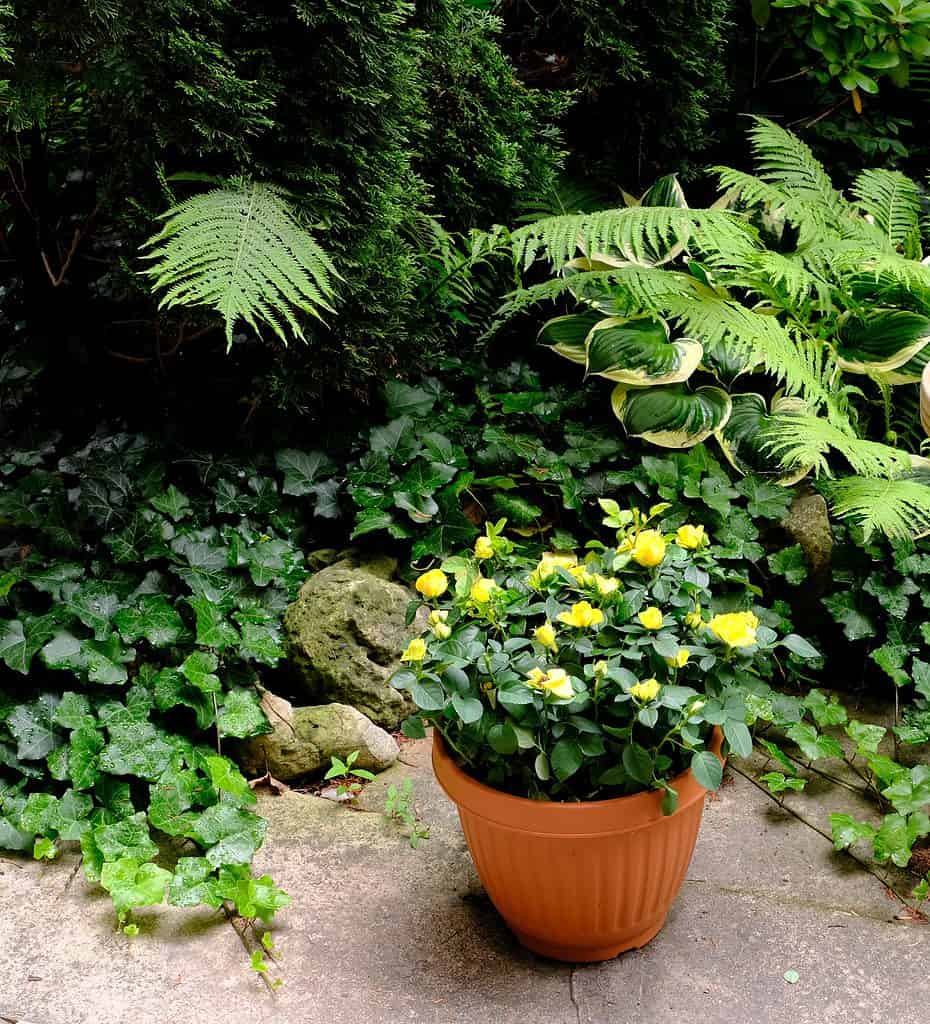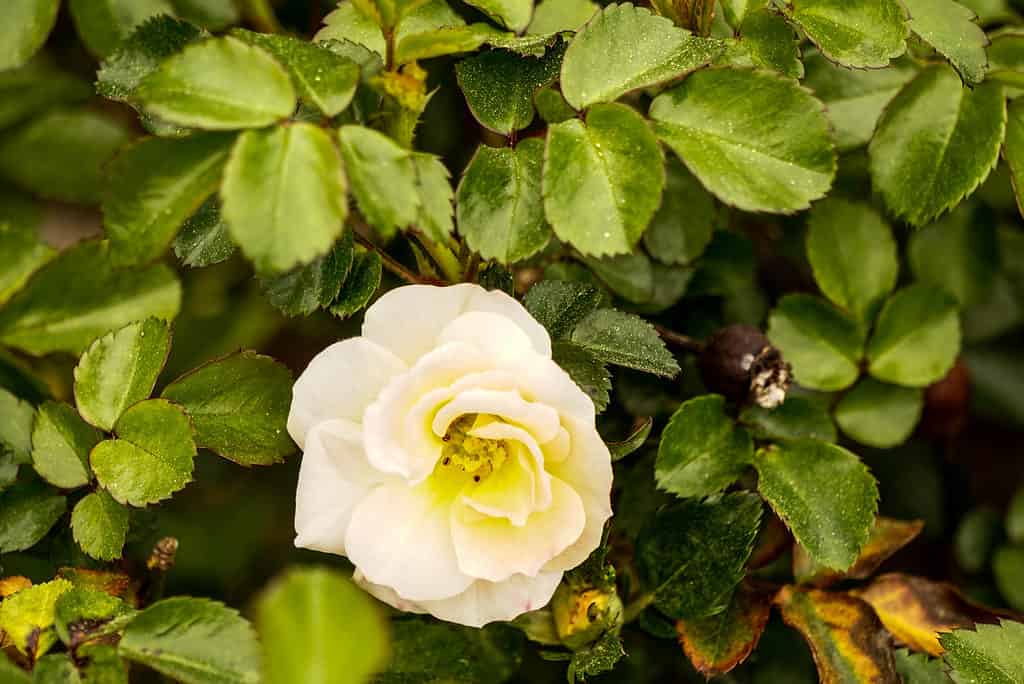If you want to fill a tiny space with the splendor of full-sized roses without their often hefty size, miniature roses are perfect. These little bloomers maintain their modest size, allowing you to plant them in pots, use them as a thin border, fill in a small corner of your garden, or use them anyplace else you want a striking display but don’t have much space. Miniature roses are also quite easy to care for.
In this guide, we’ll look at some of the best miniature rose varieties to choose from for your garden or flower arrangement.

Miniature roses (pictured) are perfect for container gardening due to their small size.
©Nancy Salmon/Shutterstock.com
What is a Miniature Rose?
Miniature rose bushes are hybrid tea roses that are bred to be very small. There are several types of miniature roses, with sizes ranging from one to three feet. Few miniature rose varieties get larger. Miniature roses are perennial plants that come in various colors and scents. Additionally, miniature roses can be found as small rose bushes or climbing roses.
Miniature roses may be grown indoors as houseplants or outside in the proper USDA Hardiness Zones due to their small, provided they receive enough sunlight. Miniature roses are common gifts for the holidays or special events like Valentine’s Day and may be purchased at garden centers and flower shops around the globe.
Now that we know what miniature roses are, let’s look at a few popular and very pretty varieties of miniature roses.
Cupid’s Kisses Rose
Botanical Name: Rosa ‘Cupid’s Kisses’
This is one of the most well-liked miniature climbing roses and a favorite of many gardeners. It is a little shrub with delicate leaves that produces several small clusters of flowers. The semi-double blooms have a white eye and are lipstick pink in color. The flowers are quite interesting due to the cluster of golden stamens in the middle of their blooms. Overall, this plant is just too adorable! It does grow a bit bigger than most miniatures, reaching a maximum height of four feet tall and a width of one to three feet when growing against a wall. Although the plant continually blooms throughout the season, the fragrance is not strong. It can thrive in USDA hardiness zone five.
All a Twitter Rose
Botanical Name: Rosa ‘All a Twitter’
This aptly-named miniature rose has deep green leaves on a two-foot stem that is densely covered in double orange flowers throughout the spring, summer, and fall. It is a perpetual bloomer that will provide you with continual color throughout the growing season. This one has tiny blossoms, but its vibrant color more than makes up for its little size. This is a fantastic alternative if you live someplace a little colder because it can withstand cold temperatures as low as the USDA hardiness zone four low average.
Liberty Bell Miniature Rose
Botanical Name: Rosa ‘Liberty Bell’
The miniature rose known as the Liberty Bell has vibrant red flower petals with a silvery-white underside. The little, lightly-scented blooms have high centers and resemble miniature blossoms of a hybrid tea rose. As they gently open up, their true beauty is revealed. The Liberty Bell rose bush has an overall height of two to three feet and a spread of one to two feet. Like many miniature roses, this rose cultivar thrives in USDA hardiness zone five.
Baby Paradise Rose
Botanical Name: Rosa ‘MEIfovett’
A group of miniature roses called Sunblaze have been engineered to be tough, disease-resistant, and very aesthetically brilliant. The Baby Paradise rose is a Sunblaze variety that transforms wherever you are located with its peppery perfume and exceptionally full vibrant pink-to-fuchsia petals. Each petal has a lovely gradient that starts out pink in the middle and changes to fuchsia towards the border. This little rose plant is hardy to USDA hardiness zone five and seldom exceeds two feet tall and broad.
Jilly Jewel Miniature Rose
Botanical Name: Rose ‘Jilly Jewel’
Try cultivating the Jilly Jewel miniature rose if you enjoy pink roses! The loveliest shade of cool pink blooms on the two-inch broad blossoms of this flower. This miniature rose variety is an excellent repeat bloomer. The plant itself is smaller than some of the miniature roses you’ll find at your local nursery, as it only grows to a height of 18 to 24 inches and a width of 12 to 18 inches. Excellent for container or pot gardening. It does well in USDA hardiness zone five in full sunlight.
Be My Baby Rose
Botanical Name: Rosa ‘Be My Baby’
Just wait and see how joyful this tiny beauty will make you and your garden guests! On a 28-inch-tall shrub, the Be My Baby rose blooms freely from spring to autumn with striking magenta flowers. The full flowers have a vivid patch of yellow in the center that may be seen if you pry apart the petals. Even better, unlike other plants, these flowers don’t lose their color over time. This cultivar, which won the 2011 ARS Award of Excellence, can withstand winter temperatures as low as the average of USDA hardiness zone four.
Gourmet Popcorn Miniature Rose
Botanical Name: Rosa ‘Gourmet Popcorn’
The Gourmet Popcorn miniature rose features white semi-double blossoms with yellow centers that resemble freshly popped popcorn. It is unquestionably lovely and petite, even when compared to other miniature roses. These little plants only reach heights and widths of 12 to 18 inches. You can expect this miniature rose variety to bloom all season. As most miniature roses are, this variety is hardy up to USDA hardiness zone five and does best in full sun exposure.

The Gourmet Popcorn miniature rose (pictured) is one of the smallest varieties of miniature roses.
©Jose Naldy Resto/Shutterstock.com
Cinderella Rose
Botanical Name: Rosa ‘Cinderella’
The Cinderella rose’s blooms are truly like something from a fairy tale. Even though this shrub is quite miniature at less than two feet tall, the blossoms are definitely not modest. They have strikingly pointed petals, are tiny but extremely full, and are white with a little pink flush. Inhale the powerful spicy scent up close, but don’t worry about thorns, as this rose variety is thornless. USDA hardiness zones five through 11 are suitable for growing this cultivar.
Coffee Bean Rose
Botanical Name: Rosa ‘Coffee Bean’
Don’t let the name fool you. These miniature roses are not brown like coffee beans. This adorable plant has two to three-inch broad smokey orange flowers that smell somewhat like tea roses. If you enjoy the ‘Hot Cocoa’ cultivar of floribunda roses, you will be intrigued by this little rose. The compact shape is ideal for container gardening or for placement at the front of flower borders. It grows 12 to 18 inches tall and broad. This hardy miniature rose can survive up to USDA hardiness zone six.
Cutie Pie Rose
Botanical Name: Rosa ‘Cutie Pie’
This small rose may seem like a quiet darling, but despite its diminutive size, it contains a lot of intrigue. With striking double flowers, each petal has a golden yellow base that changes to salmon pink at the margins. It is understandable why this cultivar got the ARS Award of Excellence in 2018, given its strong disease resistance and visual appeal. It is ideal for small spaces that require a strong color burst because it is under two feet tall.
Meibenbino
Botanical Name: Rosa ‘Meibenbino’
The hardy, self-cleaning bushes that the Knock Out class of miniature roses are known for producing have a tendency to bloom all summer long. This class’s smallest offering is the Meibenbino rose; when we say small, we mean small. It is one of the tiniest roses you can purchase because it only ever reaches a height of 18 inches and is a real teacup size. In keeping with their size, the flowers are small and extremely bright crimson or pink.
How to Grow Miniature Roses
As long as they are provided with their fundamental needs to grow, miniature roses are simple to cultivate. Choose a location for your roses where they will receive at least six hours of direct sunshine. Less light allows plants to develop, but fewer blooms are produced as a result. We recommend keeping your baby miniature roses in partial sunlight until they grow a bit, then start providing full sunlight.
Give your garden soil some sow-in fertilizer and generously top it over with compost. Because miniature roses grow continuously, many nutrients will be needed to keep the show running and the flowers blooming. These plants should be fed regularly with fertilizer, which provides the nitrogen, phosphorus, and potassium essential for healthy development and showy, healthy blooms.
Growing Tips: Miniature Roses
You can prune your miniature roses if you want, but it isn’t necessary. The only purposes of pruning, also known as deadheading, are to remove fading blooms and manage the bush’s form. Keep your plant’s soil damp but not drenched. In the dry, scorching summers, roses love a little bit of extra water.
It’s also important to prepare your miniature roses for winter, as they are quite delicate. Collaring is one of the simplest ways to overwinter any variety of rose shrub. Start by removing all the leaves from the rose shrub before applying this technique. Create a collar by wrapping a wire hoop around the shrub and tying it off with twine. To help insulate the branches, fill the collar with dry leaves, such as those that have fallen from trees in your yard. If you’d like, you can even cover the entire shrub in a piece of burlap. Add more soil, mulch, or straw to the plant’s root zone and crown to insulate the roots and shield them from heavy snow or ice.
Preventing Pests and Disease in Miniature Roses
Although miniature roses are hardy plants, the same pests that affect larger roses can also harm them.
One bug that might cause issues is the aphid. Despite their small size, these insects may harm rose plants of all sizes. Aphids should be treated with neem oil, soap or by gently wiping or spraying them off the plant. Look for them on the bottom of your miniature rose plant.
Black spot is an illness that frequently affects tiny roses. Black spot disease is brought on by the fungus Diplocarpon rosae. Cut back the impacted branches to treat your plant. Because fungus needs moisture to develop, place the rose plants in broad, direct sunlight if possible.
Another fungus that can be troublesome is powdery mildew. Powdery mildew is a fungus that appears as a powdery covering on rose plants. If the leaves on your tiny rose plant show symptoms of fungus, remove them and treat them with a fungicide formulated for rose plants.
Miniature roses may be small, but they pack a punch when it comes to adding a visually beautiful flare to garden spaces and bouquets. Just make sure that you can dedicate some time to their maintenance and ongoing care, and you’ll have lovely miniature roses for years to come.
The photo featured at the top of this post is © iStock.com/OlgaKorica
Sources
- NCSU Staff, Available here: https://plants.ces.ncsu.edu/plants/rosa/
- Sheryl Geerts, Available here: https://www.bhg.com/gardening/flowers/roses/ultimate-rose-care-guide/
- Viveka Neveln, Available here: https://www.bhg.com/gardening/plant-dictionary/rose/miniature-rose/
FAQs (Frequently Asked Questions)
Do miniature roses come back each year?
Miniature roses can come every year, as they are known for being hardy and great for propagation.
How big do miniature roses get?
Miniature roses don’t get very large. Shrubs usually reach about three feet in height.
Do miniature roses grow well outdoors?
Miniature roses can be planted outdoors, as they are quite hardy.
Thank you for reading! Have some feedback for us? Contact the AZ Animals editorial team.






